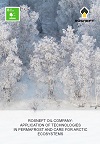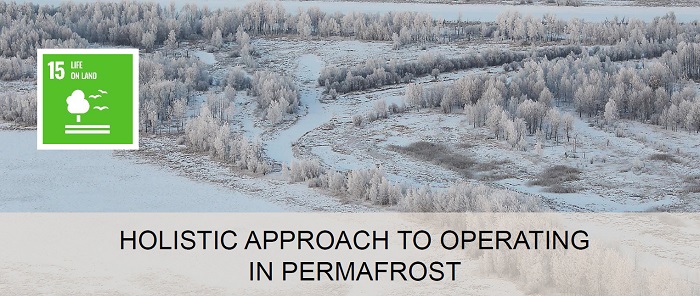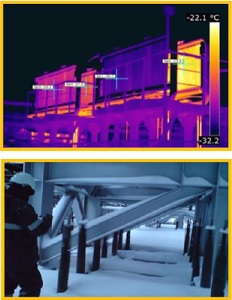Please activate JavaScript in your browser to use all interface options.
 |
Rosneft Oil Company: application of technologies in permafrost and care for arctic ecosystems |

COMPANY OPERATIONS IN PERMAFROST
Oil and gas development may involve construction in permafrost areas.
The Company gives priority to industrial safety, minimizing its environmental footprint and applying innovative approaches when operating in permafrost. A few years ago, Rosneft established the Specialized Institute for Geotechnical Research of Oil and Gas Production Facilities in Permafrost (SI GIONK) on the basis of the corporate scientific and technical research centre.
The Company applies the international HAZOP** methodology when analyzing and managing potential permafrost risks during design, engineering and operations of its assets in the area. As a result of this analysis and application of the risk management approach, the Company draws up guidelines for ensuring permafrost sustainability.

* Cryolitozone – upper layer of the earth's crust, characterized by negative temperatures of soils and rocks and the presence or possibility of the underground ice, Mining Encyclopedia, http://www.mining-enc.ru/k/kriolitozona-/
** HAZOP (HAZARD and OPERABILITY) – HAZOP study is designed to identify potential deviations from the project targets, to examine possible causes and assess consequences
Rosneft has about a fifth of its production and proven liquid reserves located in permafrost.



ENGINEERING AND CONSTRUCTION SOLUTONS FOR PERMAFROST
 Land use engineering is a set of measures aimed at preventing the detrimental geological, environmental and other impacts on land, buildings and equipment at production facilities during their construction and operation.
Land use engineering is a set of measures aimed at preventing the detrimental geological, environmental and other impacts on land, buildings and equipment at production facilities during their construction and operation.
Land use engineering includes the following:
• Vertical land levelling
• Arranging for surface water runoff
• Protecting land from flooding and water-logging
• Operations with consideration of specific permafrost conditions
The Company uses a variety of equipment to stabilize temperature of permafrost soil and prevent its thawing, including
 1. Thermocases – thermal insulating casing pipes that prevent soil thawing and ensure wellhead sustainability
1. Thermocases – thermal insulating casing pipes that prevent soil thawing and ensure wellhead sustainability
2. Insulated lift pipes
3. VET – vertical, naturally acting tubular heat stabilizers – a unique technical solution allowing for underground placement of vertical cooling pipes in the well area as well as an aboveground condenser unit at a distance of 10-20 m from the well itself, without an effect on well servicing
The Company decides on the well pad location and optimal well spacing on the basis of a feasibility study that selects the well design and additional activities that should be carried out to prevent soil thawing.

TECHNOLOGY SOLUTIONS FOR PIPELINE CONSTRUCTION IN PERMAFROST
 Construction of aboveground pipelines
Construction of aboveground pipelines
- Reinforced thermal insulation along the entire length of laying
- Electric heating systems (if necessary)
- Soil temperature stabilization near the supports and geotechnical monitoring during operations
- Selection of optimal pipe strength characteristics
- Equipment of pipelines with leak detection systems
 Installation of underground sections of oil pipelines, including sewerage systems provided by thermal insulation and with thermopiles
Installation of underground sections of oil pipelines, including sewerage systems provided by thermal insulation and with thermopiles
• Stabilizing location of the underground pipelines in order to prevent their floating in high water / summer period (buoyancy control and use of anchor supports)
• Soil temperature stabilization and geotechnical monitoring during operations
• Selection of optimal pipe strength characteristics
• Optimal route layout (bypassing areas with detrimental geological impacts)
With a view to minimizing its environmental footprint, the Company conducts a comprehensive assessment of pipeline laying reliability in permafrost, including numerous soil thawing estimates, and improves pipeline integrity by using advanced steel grades, corrosion inhibitors and internal coatings.

TECHNOLOGY SOLUTIONS FOR SITE FACILITIES CONSTRUCTION IN PERMAFROST

The Company has developed a unique technology of foundation design in permafrost that is based on creating an infrastructure facility digital model. This technology will allow for an automatic selection of technical solutions and their cost estimates.

DEVELOPING INNOVATIONS AND BUILDING CAPABILITIES
In 2020, the Company successfully tested the technology of foundation design for pipelines on piers using an infrastructure facility digital model that includes
- Guidelines for design automation
- Implementation software
- Information storage database for facilities design, engineering, construction and operation
The digital model is based on parametric geological profiles created during engineering and geological surveys. Geological profiles contain information on the ground level, geological structure, ground water level, permafrost boundaries, communication lines that will be intersected, and water barriers. In addition, the digital model is loaded with physical and mechanical soil properties, the results of stratigraphic well temperature measurements, and statistical soil testing data.
 Building capabilities, training and best practice exchange is an important activity of the Company's Research and Technical Centre Rosneft-NTTs. With regard to permafrost, the Centre's innovative and methodological activities cover
Building capabilities, training and best practice exchange is an important activity of the Company's Research and Technical Centre Rosneft-NTTs. With regard to permafrost, the Centre's innovative and methodological activities cover
- Developing capabilities for soil temperature stabilization and geotechnical monitoring
- Developing scientific and technical regulatory framework for geotechnical research
- Permafrost scientific research
- Testing and research of equipment for soil temperature stabilization.
Innovative approach to designing piles foundations of pipeline supports in permafrost allows for significantly reducing the design time and construction capital costs.

GEOTECHNICAL MONITORING
 The monitoring includes the following activities:
The monitoring includes the following activities:
- Routine and control inspection of technical floors and basements, as well as communications located in buildings
- Monitoring concrete foundations
- Monitoring natural ground temperature
- Monitoring basement air temperature
- Monitoring foundation settlement
- Monitoring foundation hydrogeological state
- Thermal imaging diagnostics of ground temperature stabilization systems operations
- Controlling the height and density of snow cover.
Geotechnical monitoring is regulated by the Federal Law "Technical Regulations on the Safety of Buildings and Constructions", the Code of Rules "Basements and Foundations on Permafrost Ground" and corporate documents.
 For example, the Company has been successfully performing regular observations and other activities aimed at ensuring mechanical safety of buildings and constructions in permafrost at the Polyarnaya GTPP gas-turbine thermal power plant, which has been successfully supplying electric and thermal power to the Vankor field cluster for more than ten years.
For example, the Company has been successfully performing regular observations and other activities aimed at ensuring mechanical safety of buildings and constructions in permafrost at the Polyarnaya GTPP gas-turbine thermal power plant, which has been successfully supplying electric and thermal power to the Vankor field cluster for more than ten years.
The Company carries out geotechnical monitoring with a view to consolidating and analyzing the field observation results, their benchmarking against the forecast, and prompt development of recommendations/ amendments to design solutions in case deviation from the forecast is found.

SPECIALIZED INSTITUTE FOR GEOTECHNICAL RESEARCH OF OIL AND GAS PRODUCTION FACILITIES IN PERMAFROST (SI GIONK)
was established in 2017 on the basis of the NK Rosneft NTTs corporate scientific and research centre for preparing solutions for the design, engineering, construction and operation of foundations in permafrost.
Examples of innovative solutions for improving safety and efficiency at the Company's projects in permafrost include
- Feasibility study of ground heat stabilizers application provides for an up to 2.3% reduction of capital expenditure due to the selection of optimal depth for pile insulation and availability of heat stabilizers, their diameter and quantity in the upper part of pile foundation (foundation grille);
- Justification of modeling and measures aimed at reducing the thermal effect of operating wells in permafrost as well as determining the optimal distance between wellheads;
- Developing modules for the prototype of the Geotechnical Monitoring information system for forecasting the thermal condition of the ground and checking the design ensuring stability of pile foundation;
- Developing the neural network algorithm for drawing up geotechnical evaluations and for compensatory actions (jointly with JSC TomskNIPIneft);
- Developing an approach to measuring ground settlement when thawing that provides for mechanical safety of buildings and installations in permafrost and avoidance of ground distortions of foundations.
SI GIONK has developed over 2,500 technical solutions for ground temperature stabilization and construction of geotechnical monitoring networks, and surveyed more than 1,500 facilities in permafrost.

PRESERVING ECOSYSTEMS AND BIODIVERSITY
In December 2019, Rosneft and the Ministry of Natural Resources and Environment of the Russian Federation signed the Agreement on cooperation in the framework of the national project Ecology. According to the signed agreement, Rosneft and the Ministry of Natural Resources and Environment will develop cooperation in the field of biodiversity conservation. In particular, the Company will implement a corporate program to study, preserve and monitor key species – bioindicators of the Arctic ecosystem resilience: polar bear, Atlantic walrus, wild reindeer and ivory gull – a rare subspecies of gull listed in the Red Book of the Russian Federation.
At the license areas in the seas of the Russian Arctic, Rosneft carries out industrial environmental control and monitoring, including accompanying observations of birds and marine mammals. The main objective of this activity is to monitor the implementation of measures aimed at minimizing the impact of operations on marine mammals as well as obtaining information on their distribution in the region of operations.
The Company is supporting a project to create an alternative energy supply system in the specially protected natural area near Cape Zhelaniya on the northern island of the Novaya Zemlya archipelago, which will contribute to the successful conservation of natural complexes of a special environmental and historical value.
For three years, the Company has been sponsoring and organizing the ecological forum ECOARCTICA, holding round tables to discuss the state of natural ecosystems in the Arctic, problems of reindeer herding, environmental safety in the development of natural riches of Arctic territories, the role of local governments in regulating the relationship between subsoil users and communities, as well as issues of preserving the traditional way of life of indigenous peoples.
The Company has released the "Russian Arctic: Space, Time, Resources” atlas. The atlas consists of 15 thematic sections and is a collection of valuable scientific data on physical geography, ecology, history of research and economic potential of the Arctic zone of the Russian Federation.

-315xx70.png)